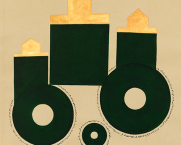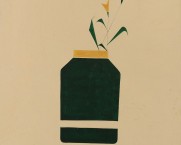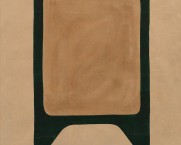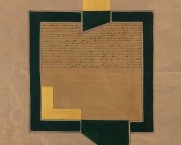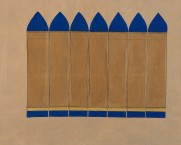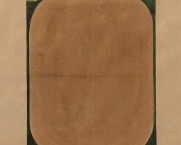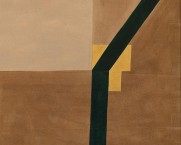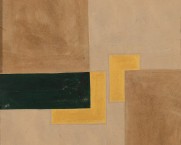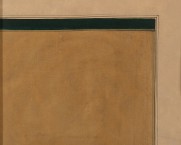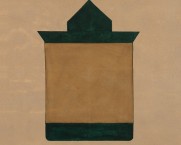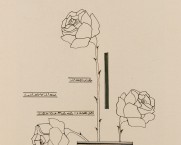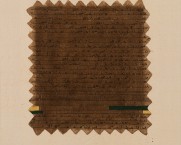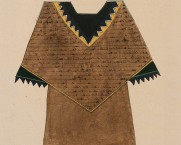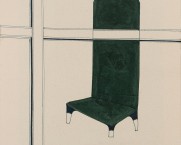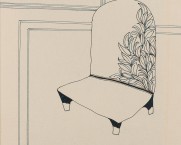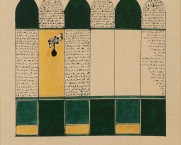C&L Shows
Qissah-e Kabul
Arshi Irshad Ahmadzai
2022

Overview
The Lost Plot, The Redeemed Refrain
Nancy Adajania
’Ālam tilism-e shahr-e khamoshān hai sar bah sar
Yā maiñ gharīb-e kishvar-e guft-o shunūd thā
The world is an illusion, a city of ghosts from end to end;
Or I am a stranger, unfamiliar with the language. [1]
—Ghalib (trans. by Mehr Afshan Farooqi)
Arshi Irshad Ahmadzai’s Qissah-e Kabul series – exhibited in 2022 at Chatterjee and Lal – opens like a clenched heart, bleeds black ink. It clouds the mirror, clouds the self, a dusty brown void looking at itself. You might recognise the occasional object occupying these paintings: a tyrant’s throne or the chair that no longer remembers the warmth of its owner’s body, a vase with flowers folded into an origami gold. But even these objects are bereft of context. Then there are the damp lapis lazuli windows, moist with tears and time, which do not know how much time has gone by. And the pulsating Malevich square, the mirror, and the slate tuned to a fugue. Then there is the contour of a tombstone or palace archway that sunlight had once graced. The light in these paintings has been interrupted many times, the dreams they hold continue to defy interpretation.
Like the stranger wandering through a ghost city in Ghalib’s couplet, we inhabit Ahmadzai’s Quissah-e Kabul, unsure of ourselves. We are visitors, or foreigners, who cannot comprehend the codes of this spectral city. This city, it appears, is a cluster of shapeshifting stories, quisseh told by an artist who traces the contours of things she loves, only to leave them incomplete, under duress or by design. There’s a story behind these half-articulated stories, the lost plot, the redeemed refrain that we sense repeatedly in Ahmadzai’s paintings. In 2021, the artist experienced at first hand the chaos that was precipitated when American forces were withdrawn from Kabul, leaving the city to the resurgent Taliban, who promptly stopped girls above the age of 12 from going to school, and re-started their gruesome practice of public floggings and executions. [2]
Caught in this cataclysmic moment, Ahmadzai was forced to leave Kabul, a city she had come to call her own through marriage. As an Indian citizen, she was fortunate enough to have been rescued by an Indian evacuation mission, which flew her out of Afghanistan. Accompanying her on her hurried flight from Kabul was a bundle of works that came to constitute the Quissah-e Kabul series. [3] She was forced to destroy more than she could take with her: she lost a hundred or more paintings bearing the female figure, as these could have attracted the censure of the Taliban, riding high on toxic masculinity. One such painting did accidentally enter the pile of the rescued works but that story will be told later in the essay.
The Suchness of Fugitive Images
Ahmadzai calls the rescued works her ‘relics’, her ‘companions’ and ‘witnesses’. “They have seen exactly what I have seen,” she asserts. We sense their historical importance, but a relic by definition reveals something partial, something that is forever looking for what was once whole. What does the viewer then see in these remnants, whose potential has been shadowed by endless cycles of violence? One possibility would be to place Quissah-e Kabul in the lineage of a classical genre of Urdu poetry – shahr-āshob, or a lament for a ruined city [4]. Here, I have in mind Ghalib’s Dastanbuy: A Diary of the Indian Revolt of 1857 on the ruination of Delhi against the backdrop of the First War of Indian Independence; it is a lament for a deeply loved home city and its special, never-to-be-restored way of life, despite the poet’s tactical complicity with the triumphant colonial power. [5] The 2021 takeover by the Taliban was only the latest in a series of bloodbaths that have consumed Afghanistan. The Afghans have not seen an orderly transfer of power since the 1970s. The Soviets and the US occupation have both pillaged the country, setting up proxy governments aligned with their respective geo-political interests. As we know only too well, autocratic ultra-religious forces began to thrive in Afghanistan through the patronage of rival neo-imperialisms.
I would suggest that Ahmadazai’s shahr-āshob is not an illustration of violence or its aftermath but a distillation of the feelings of barrenness and desolation that plague a doomed city. [6] The paintings are austere, a little hungry, very thirsty—and extremely lonely, images of a word that recurs in the shahr-āshob genre, vīrānī, the desolation of a place that had once flourished with vibrancy and prosperity. And while they may gently ooze nostalgia and an aching loss, they do not spill over into sentimentality. They are, to borrow a phrase from the great American short-story writer George Saunders’ toolbox, ’emotion-rich’. [7] Saunders privileges emotional richness over sentimentality by arguing for emotions that are ‘genuine’ or ‘earned’ rather than those that are ‘fake’ or ‘unearned’. To earn the right to emotional richness, Saunders notes that we must refine our craft, working with our chosen medium of expression like an artisan would. As a further annotation to Saunders’ caveat, I would add that such a conscious act of crafting does not result in the mere simulation of reality but rather, the illumination of experience.
What then are the illuminations that Quissah-e Kabul offers us?
Afsanah: Story, Incantation
I find it intriguing that, even as Ahmadzai has evacuated her images of a plausible narrative, the stories have fled into the titles of her paintings. Consider this: ‘Ek Gulistān begul hain jou Sayyād ki quaid mein bulbul hain’ (‘Forlorn is the garden for its darling bird is the hunter’s captive’). The horizon lines in the accompanying image insinuate neither utopia nor dystopia. In this eerily silent painting, we are surrounded by the barely perceptible hum of a lost promise. A lone black bracket in the lower left corner of the image – similar to a photo corner holding a memory in reserve for posterity – steadies our pulse. For the eternal optimist, a smidgen of gold on the horizon flashes like a brief insurrection. A missive in Urdu below the horizon bands nudges the viewer to read the text. Even if you knew Urdu, dear viewer-reader, your eye would be thwarted by a conundrum. Because the artist often scripts imaginary conversations into her images without the dots or nuqta on the Urdu characters, sapping the words of meaning, defeating the very purpose of communication.
We are perplexed by this quick closing of the gap between inviting viewers to read the image and thwarting them. The artist makes a strange confession: “When it comes to writing, I think of myself as a nākaam shāyar or a failed poet who can’t even recite her own ash’ār or couplets. Since I am anxious about reciting my own ash’ār, I use them in my artworks without dots, making the script unreadable. This comforts me somehow. It’s like keeping a secret diary.”
While the text inside the artworks may function as a hermetically sealed private language, even if in public view, the titles of the paintings carry the scent of the familiar, at least for those who are immersed in the literary universe of Urdu and Persian. Apart from the literary giants, Mir and Ghalib, Ahmadzai’s poetic imagination has also been formed by the shayari of the beloved 17th century Afghan Sufi poet-saint Bedil Dehlavi, as well as other popular Urdu poets from the subcontinent such as Parveen Shakir, Jaun Elia, Faiz, and Faraz. Readers of Urdu poetry will grasp the classic Urdu topos in the title lamenting the Sayyād or hunter’s trapping of the bulbul. The image points to the soul that is held captive by the nafs or baser nature, unable to be part of the larger infinity of creation. But when we read this title in the context of Quissah-e Kabul, the mystical reading becomes layered with a political provocation. The Sayyād is also a symbol for authoritarian rulers who crush all forms of dissent and refuse to let the garden of democracy bloom.
Ahmadzai grew up in a household where the exchange of poetry was an afternoon pastime or shugal. “I remember all the girls in my haveli secretly kept a diary of their own ash’ār. Or sometimes their favourite ash’ār culled from various poets. In summertime, after lunch, seeing this diary and reciting from it was like tawaf-e Kaaba or a walk around the Kaaba.” Najibabad, in Uttar Pradesh, where she was born and brought up, is home to the Rohila Pathans, many of whom stem from the Yusufzai tribe in Afghanistan. Her mother, who has Afghan roots, belongs to this tribe; her great-grandparents came from Kandahar. The artist began to call Kabul home after she married into an Afghan family in 2017; her husband is a Hindustani classical singer. Her paternal family, on the other hand, traces its roots to Damascus.
Ahmadzai draws on this large transregional bloc, extending from Istanbul to Hyderabad, which for many centuries had been unified by its use of Persian as a court language and a literary medium. The Indian subcontinent, being richly multi-lingual, was nourished by Persian, Sanskrit and Prakrit sources, especially during the Mughal period when the imperial court commissioned many translations across these languages. This is the rich cultural backdrop that nourished Ahmadzai’s family. Her mother, an excellent storyteller, was an Arabian Nights dream come true. She regaled Ahmadzai with her never-ending quisseh: folklore she had heard from her grandmother but also stories from the Shahnameh, the Panchatantra and the Amar Chitra Katha series; Islamic stories about prophets and messengers, and the story of Ādam and Havvā. It was her mother who introduced her to Urdu poetry and cinema. “I think she opened the gates of my imagination.”
While Ahmadzai inherited the aesthetic and philosophical refinements afforded by an Indo-Islamicate culture from her beloved mother, her mother never had the opportunity to fulfil her literary gifts. Elsewhere, Ahmadzai praises her mother’s writing, ruefully adding that she kept a diary and wrote in it every day “only to place it in the junkyard of the house.” [8] Not everyone has supportive parents like Ahmadzai. She admits that education of girls is a major challenge faced by her community. Today, the issues faced by Muslim women in India have been aggravated in a feverishly communalised environment matched by an increasing Wahhabisation of Islam. [9]
The Desolate Streets
I find only one street name among the other more existentially charged titles of the paintings in Quissah-e Kabul. It is the street in Kabul where Ahmadzai found a lone chair (‘Yeki az choki-e Shor Bazaar’).
“Yes, the Shor Bazaar area interests me in so many ways. During a short visit to my in-laws’ haveli, I have felt connected to its old architecture, chai khana (coffee houses), old wooden doors and windows with beautiful wood carvings. Before the 1990s, Shor Bazaar was famous for its poets, musicians and considered a spiritual place for so many. During the reign of Amir Sher Ali Khan in the 19 century, a few Indian musicians migrated to Afghanistan and made Shor Bazar their home. Now that area is called kūche kharābat. Shor Bazar was the centre of Kabul. Descendants of these musicians still live in kūche kharābat. Shor Bazaar was also home to many Sikhs. But during the Taliban’s occupation in 2018, almost 90 percent of the Sikhs left the country and moved to India, Canada and USA. There is a Dharamshala, a Sikh temple in Shor Bazaar. I found the chair in front of that temple.”
The appellation for Shor Bazaar – ‘kūche kharābat’ – is truly disappointing. The word ‘kharāb’, common to Urdu, Hindi and Gujarati (which happens to be my mother tongue), secretes the slow poison of desolation and rottenness. A bleak street that now spells barrenness. This story of a street ringing with couplets and music that the artist narrates at my prompting. This story of a street torn apart by bombs is not present in the painting she paints. What appears instead is a low chair – stained with pomegranate peel, a deep shade of brown – that sits close to the ground. But where is the ground in this painting? This chair is a word that once belonged to a sentence, but the sentence has vanished, abandoning it to a void. All that holds the chair in place is a bracketing linear frame with a prominent corner, a spatial parenthesis that is provisional, makeshift, uncertain whether it can offer the chair a tent or a palace as habitat. At best, the corner dynamizes space in this painting, rescues the chair from free fall.
The artist concurs that “creating corners in her paintings is like making a place to rest, to sit, to think. And often, it is like resting the heart in between these corners and lines. It allows me to breathe in an artwork. I always prefer to sit in a corner while working. It comforts me somehow. Corners hold you like two arms. It gives structure to the space, and warmth.” Consider the interrupted diagonal and the empty square in ‘A Lone Slice of Bare Earth’ and the yellow brackets holding two different universes really close, but not quite touching each other, in ‘The Chasm Between Light Interrupted for Eons and Bare Earth’ or ‘A Thought at the Verge of Erasure’ holding on to a faint, unerasable heart. [10]
The Wounded
‘When the Sun’s Rays Kiss the Earth’, a shimmer of gold on velvety black: we want to believe that love will triumph over separation and schism. But we are mistaken. The perfect contours of a once glorious, sun-kissed monument can be flipped into a distant aerial view in a moment. Beauty and tragedy are the cornerstones of Urdu poetics and Ahmadzai knows how to tackle them with hunar, twinning the artisanal with the affective. But the world of Quissah-e Kabul was shattered long ago, these fragments are her only talismans. Hers is an aesthetic of the fragment and the ruin, the half-glimpsed, the unsaid. The story is that there is no single story, or at least not a complete one.
I would like to end this essay with the single figurative painting that ended up in the rescued works by mistake. Ahmadzai has crafted its title as a question and a complaint or shikwa – ‘Na hoti main tou kyā hoti’ (‘What would I be if not for myself…?’). This fragment is taken from a deeply philosophical and layered couplet by Ghalib. In contrast to the assertive title, the image is one of Ahmadzai’s quintessential faceless woman with a bleeding heart. We could paradoxically read the blank face as a resistance to patriarchal repression. By not allowing for a label or construct to limit her female figures, the artist liberates their faces from all the societal masks forced upon them – leaving them blank, so that they can write a new narrative.
But let us return to the bewildering title of the painting. Ahmadzai has changed the gender of the lines by inflecting the first-person voice with a female subjectivity. For some time now, the artist has been wrestling with the preponderance of male exemplars, whether in Urdu poetry or in Islamic stories. By making the utterance female, the artist is perhaps making place for the affective knowledge that women inherit from their mothers and grandmothers, experientially and intimately. The term ‘affective’ is often misunderstood as the opposite of ‘cognitive’, as a wash of unexamined emotions. In fact, the affective approach allows for intuitive forms of grasping knowledge. It instigates an alternative way of being and experiencing a world broken into pieces, by healing each piece with colours and herbs.
The ontological complexity of the title ‘Na hoti main tou kya hoti’ compels me to ask Ahmadzai what, if she wasn’t herself, she would be. She replies: “I don’t have the exact answer but perhaps ek be-alfāz rubāi hoti ya Nasreen [Mohamedi] ke kisi kām ki ek khāmosh kachchi lakeer hoti.” A wordless quatrain or a silent, raw line in one of Nasreen’s drawings.
Coda
Now that she lives in Weimar, I ask Ahmadzai what she misses most about Kabul.
— Koh-e Asamai, the mountain of the goddess Asamai and a serene star-filled night spent on it. [11]
— Hamām, the traditional sauna for women. It was fascinating for me to see burkha-clad women coming to the hamām, being nude, having a bath together, chatting, sharing their intimate stories, sadness, pain, joy and laughing while rubbing soap on each other’s back, emotionally comforting each other.
— Gul-e lalah, wild red flower
— And gardens
Notes
1. Mehr Afshan Farooqi, Ghalib, Flowers in a Mirror: A Critical Commentary (Gurugram: Penguin/Allen Lane, 2024), p. 9. The poem by Ghalib that I have chosen as an epigraph for this essay is intriguingly called a kharij poem, one that was ‘edited out’ of the corpus by the poet because of his extremely self-critical nature. He seems to have discarded more than half of his Urdu verses, during the process of preparing the printed editions of his ghazals. For this book, Farooqi has selected 30 ghazals from this rejected corpus, which, as she demonstrates through her critical annotations, include some very fine poems.
2. Lindsay Maizland, ‘The Taliban in Afghanistan’ in Council on Foreign Relations, January 19, 2023. Retrieved from https://www.cfr.org/backgrounder/taliban-afghanistan
Women in Afghanistan are the biggest casualty of the Taliban regime.
Ahmadzai has talked about her cousin Estorai, a scholar of botany from the Balkh province, whose future was destroyed by the return of the Taliban in 2021. Since the Taliban were urging parents to marry their daughters to them by force, Estorai fled with her family to Kabul and stayed with Ahmadzai. There, she hastily married a relative to escape the fate decreed for her by the Taliban. Ahmadzai worked with Estorai on ‘Quissah-e Qutub Minar’ in the Objects Reimagined series commissioned by Sarmaya in 2021. Refer to https://sarmaya.in/exhibitions/reimagine-ii/
3. I asked Ahmadzai whether, apart from the paintings, she had been able to rescue anything else that she could not possibly live without. She replied: “My husband was in a safe house provided by the Germans. I left Kabul without meeting him and it broke my heart. So, I carried his childhood photo with me, also my mother’s chandi ke kaam ki Banarasi sari, embroidered in silver thread, which she wore on her wedding day; she gifted it to me. These were the two things apart from the paintings that I took with me.”
All the artist quotes that appear in this essay are selected from a conversation with the present author, January 2, 2024 unless otherwise indicated.
4. According to the online Rekhta Dictionary, a shahr-āshob describes the plight of a city in socio-political and economic crisis and has historically been composed “in the form of Masnavi, Qasida, Rubai, Mukhammas, Qita and Musaddas.”
Retrieved from https://www.rekhtadictionary.com/meaning-of-shahr-aashob
5. Apart from Ghalib, other famous Urdu poets like Dagh Dehlvi and Maulana Hali have also written shahr-āshobs on the catastrophic ruin of Delhi during the First War of Indian Independence.
6. The palette of these artworks is restrained too, mainly browns with flecks of rust and dead skin; emerald green but also green poisoned by the long night of history; gold, the yellow of raw sunlight; luminous black; and lapis lazuli. “I have learned to extract a few pigments from my mother-in-law. For example, from anār or pomegranate peel, green walnut peel (it gives a permanent dark brown tone), rang-e zafran from saffron, gul-e leili from a wild flower, lapis lazuli from a lajward stone.”
7. George Saunders, ‘On Sentimentality and What Forms Us’, February 22, 2024. Retrieved from Saunders’ Substack, ‘Story Club with George Saunders’.
8. Artist quoted in Shailaja Tripathi, ‘With Lihaaf, a quilting project, artist Arshi Ahmadzai and her collaborators embroider a challenge to patriarchy’ in Firstpost, August 15, 2020. Retrieved from https://www.firstpost.com/art-and-culture/with-lihaaf-a-quilting-project-artist-arshi-ahmadzai-and-her-collaborators-embroider-a-challenge-to-patriarchy-8699101.html
9. In the spirit of giving back to the community, Ahmadzai initiated a collaborative quilting project with young Muslim women of Najibabad in 2020. To give them however brief a respite from their oppressive situation. To imagine another world where they can be themselves, without any restrictions.
10. The Urdu titles of these paintings are as follows: ‘A Lone Slice of Bare Earth’ (Kachchi Zameen ka Tanhā Tukda); ‘The Chasm Between Light Interrupted for Eons and Bare Earth’ (‘Muddatton se Thehri Roshni aur Kachchi Zameen kã Fāsla’) and ‘A Thought at the Verge of Erasure’ (‘Ek bāt jo na jāne kab mit jāye’).
11. Here’s the artist’s original bilingual response: “Koh-e Asamai (mountain of goddess Asamai) aur uss per thehri pursukoon taaron bhari rāt.”
A Video Walkthrough by Mort Chatterjee

